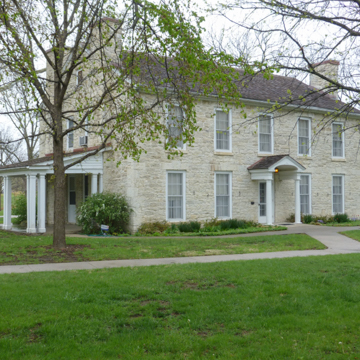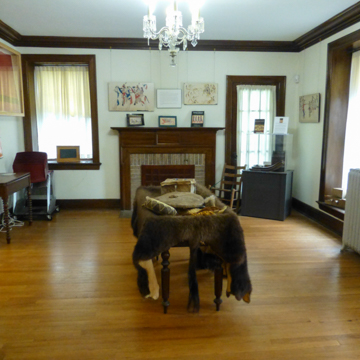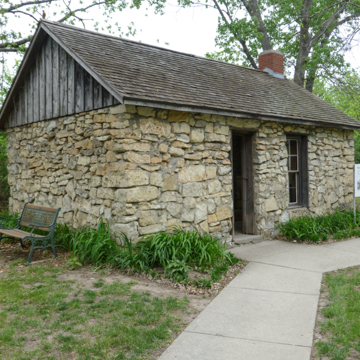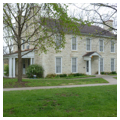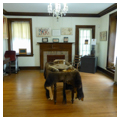The Kaw Methodist Mission is a reminder of the clash of cultures involved in the settlement and development of Kansas. The mission was established as a consequence of an 1846 treaty between the U.S. government and the Kaw, or Kansa, a Native American tribe relocated from a much larger area of land in the northern part of the state to a twenty-square-mile parcel that included the town of Council Grove. As part of this treaty, the government agreed to provide educational resources to the Kaw. Construction of the mission building began in 1850.
The mission is located about one-half mile north of Council Grove along the Neosho River, which provided fresh water to the school, and beneath a hill where limestone for the building was quarried. The simple, two-story, rectilinear structure contained four rooms on each floor. The lower level originally housed the staff and a classroom, while the rooms on the upper floor accommodated up to fifty Kaw students. The students spent their mornings learning to speak, read, and write English, to master simple mathematics, and to be indoctrinated in Christian principles and beliefs. Afternoons were spent working in the fields to teach them about American agriculture methods firsthand.
The government contracted the Methodist Episcopal Church South, which was running the Shawnee Manual Labor School near Kansas City, to operate the mission in Council Grove. The Shawnee Mission sent Thomas Huffaker to oversee the new mission along with a manager of the agricultural fields and a housekeeper. Neither Kaw leaders nor the students sent to the mission were enthusiastic about the endeavor. The tribe sent no more than thirty young men, who were either orphans or wards of the tribe, to study at the mission. The young Kaw men saw themselves as hunters rather than farmers, and valued their own traditions above those being taught to them at the school. Some left the school and returned to the tribal village. In 1854, after only three years, the school closed, in part because of greater than expected costs of operation, and in part because of the lack of interest among the Kaw.
Relations were generally good between the Kaw and the growing number of white settlers flowing into and through Kaw territory, but inevitable resentments and misunderstandings arose between cultures with very different values and aspirations. In 1859 tribal members came into Council Grove and killed several settlers. After this the Kaw territory was reduced in size to a nine-by-fourteen-mile parcel that excluded the town of Council Grove. Then, in 1873, despite the protests of their leaders, the Kaw were forced to relocate once again, to Indian Territory in Oklahoma, and to give up their remaining land in Kansas.
The mission building was sold to Thomas Huffaker, who had married Eliza Ann Baker, the daughter of the housekeeper, and who had become a successful businessman in Council Grove. Several of the Huffaker children lived in the house, and in 1926, after the death of Thomas and Eliza, their youngest son undertook a major renovation of the building. He put in steam heating and indoor plumbing, installed new interior finishes including oak flooring and rosewood molding, and added several porches. The alterations, particularly the Colonial Revival porches, made the house look significantly younger than its true age.
In 1951, the State of Kansas acquired the mission building from the Huffaker family, and opened it as State Historic Site dedicated to the memory of the Kaw Nation. It quickly became a favored tourist destination. In 1961, the local Rotary club dismantled one of the 138 huts the U.S. government had erected for the Kaw on their post–1859 diminished territories, and reassembled it on the grounds of the Kaw Mission. In recent years, the Kaw have acquired a large portion of their final Kansas homeland, and have begun to stabilize deteriorating buildings and reestablish the prairie landscape as a way of honoring their heritage.
NOTE: This entry was originally published in David Sachs and George Ehrlich, Guide to Kansas Architecture (Lawrence: University Press of Kansas, 1996). © 1996 by the University Press of Kansas.
References
Pankratz, Richard D., “Kaw Methodist Mission,” Morris County, Kansas. National Register of Historic Places Inventory-Nomination Form, 1971. National Park Service, U.S. Department of the Interior, Washington, D.C.














